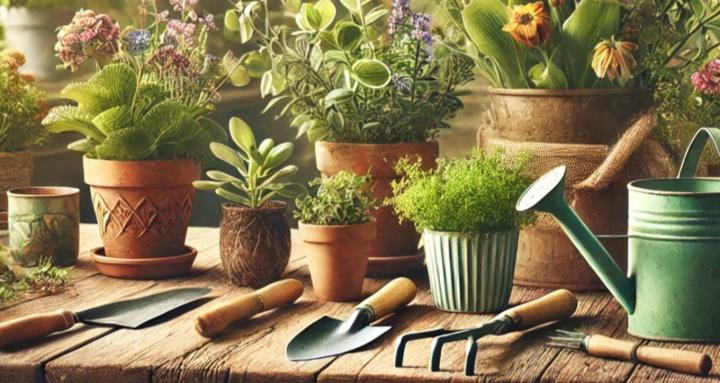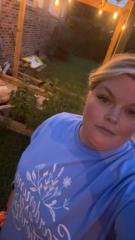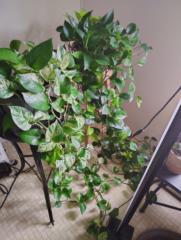Jun 2 • Garden Gear & DIY Hacks
How to Make a Simple Raised Bed Garden for Containers
Raised bed gardens aren't just for large yards—they can be perfectly adapted for container gardening too. A raised bed dedicated to containers helps organize your plants, improves drainage, reduces weeds, and makes gardening easier and more accessible. Here’s how you can create a simple, practical raised bed specifically for your container plants.
𝐁𝐞𝐧𝐞𝐟𝐢𝐭𝐬 𝐨𝐟 𝐚 𝐑𝐚𝐢𝐬𝐞𝐝 𝐁𝐞𝐝 𝐟𝐨𝐫 𝐂𝐨𝐧𝐭𝐚𝐢𝐧𝐞𝐫𝐬
* 𝐈𝐦𝐩𝐫𝐨𝐯𝐞𝐝 𝐃𝐫𝐚𝐢𝐧𝐚𝐠𝐞: Elevation allows excess water to drain away, preventing soggy conditions.
* 𝐄𝐚𝐬𝐢𝐞𝐫 𝐀𝐜𝐜𝐞𝐬𝐬: Reduces strain on your back and knees—perfect for gardeners of all ages.
* 𝐁𝐞𝐭𝐭𝐞𝐫 𝐎𝐫𝐠𝐚𝐧𝐢𝐳𝐚𝐭𝐢𝐨𝐧: Clearly define growing areas, making plant care simpler and more effective.
𝐌𝐚𝐭𝐞𝐫𝐢𝐚𝐥𝐬 𝐘𝐨𝐮’𝐥𝐥 𝐍𝐞𝐞𝐝
* Lumber (untreated cedar or composite boards are ideal)
* Screws or nails
* Drill or screwdriver
* Landscaping fabric or weed barrier (optional)
* Gravel (optional, for added drainage beneath containers)
* Containers suitable for your plants
𝐒𝐭𝐞𝐩-𝐛𝐲-𝐒𝐭𝐞𝐩 𝐆𝐮𝐢𝐝𝐞 𝐭𝐨 𝐁𝐮𝐢𝐥𝐝𝐢𝐧𝐠 𝐘𝐨𝐮𝐫 𝐑𝐚𝐢𝐬𝐞𝐝 𝐁𝐞𝐝
𝐒𝐭𝐞𝐩 𝟏: 𝐂𝐡𝐨𝐨𝐬𝐞 𝐘𝐨𝐮𝐫 𝐋𝐨𝐜𝐚𝐭𝐢𝐨𝐧
* Select a sunny, flat spot with easy access. Most container gardens benefit from at least 6 hours of direct sunlight daily.
𝐒𝐭𝐞𝐩 𝟐: 𝐃𝐞𝐭𝐞𝐫𝐦𝐢𝐧𝐞 𝐒𝐢𝐳𝐞 𝐚𝐧𝐝 𝐃𝐞𝐬𝐢𝐠𝐧ine
* Consider the space available and your container sizes. Common sizes for container raised beds are 4 feet by 8 feet or smaller. Beds should ideally be no wider than 4 feet for easy reach.
𝐒𝐭𝐞𝐩 𝟑: 𝐁𝐮𝐢𝐥𝐝 𝐭𝐡𝐞 𝐅𝐫𝐚𝐦𝐞
* Cut lumber to desired dimensions.
* Assemble the frame by screwing or nailing the corners together securely.
* Ensure the frame is level by adjusting the ground beneath it as necessary.
𝐒𝐭𝐞𝐩 𝟒: 𝐏𝐫𝐞𝐩𝐚𝐫𝐞 𝐭𝐡𝐞 𝐁𝐞𝐝
* Line the bottom with landscaping fabric to help prevent weeds.
* Add a thin layer of gravel to improve drainage and keep pots elevated.
𝐒𝐭𝐞𝐩 𝟓: 𝐀𝐫𝐫𝐚𝐧𝐠𝐞 𝐘𝐨𝐮𝐫 𝐂𝐨𝐧𝐭𝐚𝐢𝐧𝐞𝐫𝐬
* Place your containers strategically within the raised bed, ensuring each has room for growth.
* Consider plant height and spread to maximize sunlight exposure and air circulation.
𝐓𝐢𝐩𝐬 𝐟𝐨𝐫 𝐒𝐮𝐜𝐜𝐞𝐬𝐬
* 𝐂𝐡𝐨𝐨𝐬𝐞 𝐭𝐡𝐞 𝐑𝐢𝐠𝐡𝐭 𝐂𝐨𝐧𝐭𝐚𝐢𝐧𝐞𝐫𝐬: Ensure your pots have drainage holes and are appropriately sized for your plants.
* 𝐔𝐬𝐞 𝐐𝐮𝐚𝐥𝐢𝐭𝐲 𝐏𝐨𝐭𝐭𝐢𝐧𝐠 𝐒𝐨𝐢𝐥: A rich, well-draining potting mix will provide the best results.
* 𝐂𝐨𝐧𝐬𝐢𝐝𝐞𝐫 𝐃𝐫𝐢𝐩 𝐈𝐫𝐫𝐢𝐠𝐚𝐭𝐢𝐨𝐧: This helps maintain consistent moisture, especially in hot climates.
𝐌𝐚𝐢𝐧𝐭𝐚𝐢𝐧𝐢𝐧𝐠 𝐘𝐨𝐮𝐫 𝐑𝐚𝐢𝐬𝐞𝐝 𝐁𝐞𝐝 𝐂𝐨𝐧𝐭𝐚𝐢𝐧𝐞𝐫 𝐆𝐚𝐫𝐝𝐞𝐧
* Regularly monitor watering needs—containers dry out faster than garden soil.
* Fertilize plants as needed with a balanced, slow-release fertilizer.
* Rotate your containers periodically to encourage even growth and exposure to sunlight.
With a simple raised bed designed specifically for containers, you’ll enjoy an organized, beautiful, and easily manageable garden space. Happy container gardening!
1
3 comments

skool.com/gardening
🌱 Unlock your green thumb in the most supportive container gardening group online — exclusive tips, plant hacks, and growing wins await!
Powered by





